To sign up for our daily email newsletter, CLICK HERE
Search engine optimization, or SEO, is one of the most important aspects of running an eCommerce business in 2021. SEO is the process of creating content and optimizing your website to get it to rank higher on the search engine results pages, or SERPs. In this article, we’re going to outline how you can use SEO to reach the right people and ultimately increase your bottom line.
Need more professional help? Take a look at some of the SEO packages Loganix has to offer. We can help you build a content strategy, secure backlinks, and more.
Let’s get started.
Target the most appropriate keywords on every web page
To begin, it’s important that you target the right keywords with your website copy. This will ensure that your website ranks for the right queries on search engines so you reach the most suitable people.
Head to a keyword research tool like Google Keyword Planner with a list of words and phrases relevant to your business. Plug these in and Google will provide you with a list of keywords that people are searching for based on their competitiveness, or how hard they are to rank for, and their average monthly search volumes. These are the words relevant to your business that people are searching for! Weaving them into your content and web page copy is an excellent way to ensure that you are drawing in people that are searching for things relevant to your business.
Let’s take a look at an example of a business that has targeted keywords on their homepage well.

HubSpot, another digital marketing expert, has targeted keywords well in their article on email newsletters. They rank on the first page of Google for keywords with a collective monthly search volume of 1,852. They’ve incorporated relevant keywords and phrases throughout their copy, including “email newsletter ideas”, “newsletter design”, and “email marketing”. Their strategy has proven successful, considering their high ranking in the SERPs.
On your website, be sure to target relevant keywords and phrases throughout your copy, particularly in important places like in titles, headers, and navigation sections, to rank higher on the SERPs.
Create content for every stage of the buying journey
People at different stages of the buying journey have different needs — you need to create content with this in mind. For instance, some people might not know your services exist yet (and that they need them), while others might just be weighing up their options before making a purchase.
This is a great way to help boost your SEO, as it will catch people at various stages of the buying journey, during the awareness, consideration, and decision stages. Having different kinds of content to attract each of these different types of people is a great way to boost your SEO and bring in more customers.
Let’s look at a few examples of businesses that have implemented this tactic well.
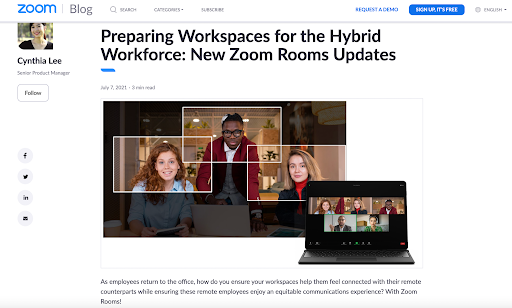
Zoom, a video conferencing service, saw their usage boom during the COVID-19 pandemic. As restrictions lift and workers return to the office, Zoom has to retarget their users in order to keep them.
This particular article targets people at the end of the customer buying journey — people who read this article already use Zoom products, but are looking for new ways to incorporate them into a partially work-from-home office. The article discusses how to prepare workspaces for a hybrid workforce using their new updates, like voice commands, in-meeting chat, and various software updates.
On your website, consider creating content that shows your users that the products they know and love can be used in new ways. This is a great way to get people to use your products or services again.
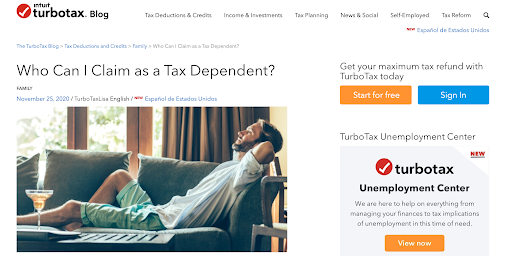
TurboTax, on the other hand, targets people at the beginning of the buying journey. This article tells the reader who they can claim as a tax dependent. People searching for this online might not be aware that TurboTax can provide tax assistance, not just in the form of blog posts, but through their various tax preparation software products.
On your website, think about what kinds of articles you can write that will draw people in to learn about your services. Think of what types of questions they might have before finding your products!
Make sure your site offers a positive user experience
If your website doesn’t offer a positive user experience, internet users won’t stick around for long enough to make a purchase. When this happens, your bounce rate will increase. Your bounce rate is the percentage of visitors that come to your website and immediately leave after viewing just a single page. When this happens, it tells Google that your website isn’t helpful to the customer, which hurts your SEO.
Here are some tips for improving your website’s user experience:
- Have a fast loading speed (generally, keep it under two seconds)
- Make it easy to read with a legible font
- Have a simple design that helps users determine where they need to go
- Create an intuitive navigation
- Give your users all of the necessary information they’ll want before converting
Let’s look at a few examples of websites that provide a positive UX for inspiration.
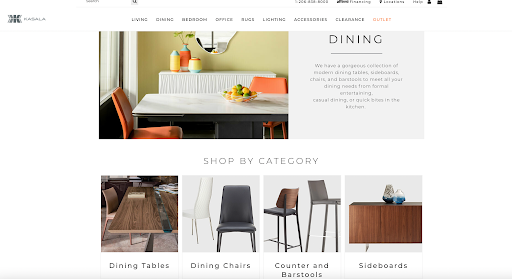
Kasala, a furniture company based out of Seattle, creates a positive user experience by making it very easy for customers to find what they’re looking for on any given category page.
On their dining room furniture page, for instance, they break down this type of furniture into sections to help the customer find what they are looking for very easily. This is a great way to give your website visitors a positive experience. On your website, consider breaking down different categories into their own sections to make it as easy as possible for your customers to find what they’re shopping for.
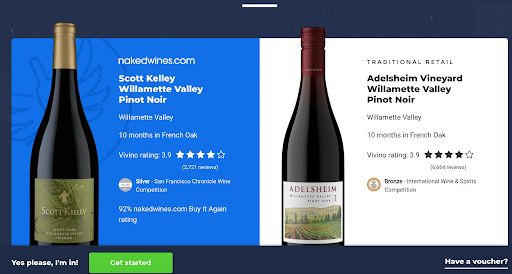
NakedWines, an online wine delivery service, provides a positive experience for their customers on their homepage, as well.
If you scroll down, a bar will show up on the bottom of your screen offering two calls to action: one to get started, and one for website visitors who have a voucher. NakedWines tends to send vouchers for free wine in the mail to draw customers in — telling these people where they need to go once they get to the website is a great way to ensure these people convert. On your website, be sure that anyone who comes to your website knows where they should go to take the next step with your business.
Always add relevant internal links to your web pages
Internal links are very important for SEO! Internal links, or links that send users to a different piece of content or section of your website, help search engines determine how your website is structured, what different pages contain, and which web pages are the most important.
Link to your own web pages wherever it’s logical. This could mean including them naturally in your navigation or category copy, adding related categories to each page so customers can easily browse more products, or by including internal links in your blog content where it’s relevant so your readers have a place to learn more.
Let’s look at a few examples of businesses that have included relevant internal links throughout their website well.

Dainty Jewells, a women and girls’ clothing retailer, includes relevant internal links throughout their website, including on their page for wedding dresses.
Because they sell clothing for both adults and children, they must break down these categories to help their customers and Google navigate through their website easier. Creating various subcategories, like brides, bridesmaids, and flower girls, helps to give structure to the website and boosts Dainty Jewells’ SEO as a result. On your website, be sure to break down any broad categories using internal links so your customers can find the products or services most relevant to their needs.
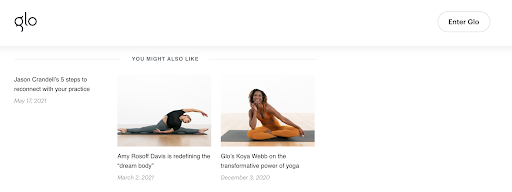
Similarly, Glo, an online yoga, meditation, and fitness program, uses relevant internal links in their blog articles.
Each post has a section at the end that tells the reader what other similar articles they might like. This article, in particular, discusses the healing powers of yoga. Related articles include redefining the dream body and reconnecting with your yoga practice. Not only is this a great way to keep readers on the website, but it gives Google more context as to what these articles are about and who they should send to Glo’s website. On your blog, don’t be afraid to link to your own content, whether in a related article section or throughout your copy.
Create content that your audience is looking for
Content marketing is a major part of SEO. It’s the process of creating regular content for your website to attract more customers. You can come up with topics for content marketing by conducting keyword research, offering free tools or samples, or by answering questions that your audience has, for instance. Doing this will also help show that you are an expert in your field, which is an excellent way to rank higher on the SERPs.
Here are a few different types of content you could create for your website to show off your expertise and draw in more customers:
- How-to guides that outline a process step-by-step
- Ultimate guides that tell a reader everything they need to know about a topic
- Virtual try-ons or styling guides
- Articles on industry news
When optimizing your content for SEO, be sure to target keywords and address any questions or pain points your customers have. Not sure what your customers’ pain points are? Check in with your customer service team and see if there are any questions they get frequently. Basing your content off of these questions will make your customers feel understood and give you an SEO boost.
Let’s look at a few examples of businesses that have created excellent content with these suggestions in mind.

BarkBox, a dog toy subscription service, has a blog post on what a DNA test can tell you about your dog. The article discusses how a dog DNA test can tell the owner more about behavior, the best toys for them, health risks, and more.
This is a great article that is not only helpful and informative to BarkBox’s customers, but it can help increase sales as they promote their toys throughout the piece. On your website, consider discussing trends in your industry and see what kinds of content you can create surrounding it.
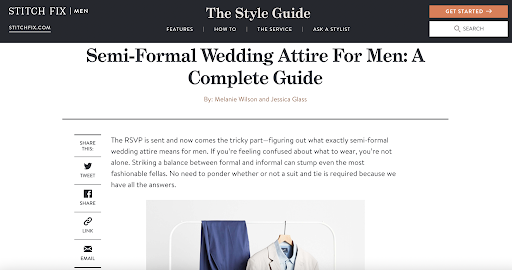
Similarly, StitchFix, an online personal style service, has a styling guide for semi-formal wedding attire.
The guide outlines what semi-formal wedding attire is, different color schemes and styles based on the time of day, and more. This is a helpful article, and people that come across this are likely to be interested in StitchFix’s other personal styling services, such as their subscription box. This means that it is excellent in boosting their SEO! If you work in retail or beauty, consider offering a styling guide for your products so customers can see different ways they can wear your products before making a purchase.
Summary
SEO is one of the most important aspects of running an eCommerce business today. There are a lot of different strategies to help ensure that your website is shown to the right audience! In this article, we discussed keyword research, content marketing, creating a positive UX, and more. Keep these tips in mind throughout your eCommerce journey. There’s work to be done!
—
Author bio & headshot:
Adam Steele is COO and co-founder of Loganix, which is an SEO fulfillment partner for digital marketing agencies and professionals. The company provides the SEO services that businesses need to grow and achieve their goals. If you enjoyed this article, you can find more SEO guides and templates on the Loganix blog.
